Example Data¶
Example 1: GSN station KIP¶
Description: 20 days of LHZ (1 sps) data from 2 co-located broadband sensors:
- “Known” instrument: a Streckeisen STS-1VBB w/E300 (00_LHZ.512.seed; RESP.IU.KIP.00.LHZ); and
- “Unknown” instrument: a Streckeisan STS-2.5 (10_LHZ.512.seed, RESP.IU.KIP.10.LHZ).
The Streckeisen STS-1VBB has a flat frequency response that extends to lower frequencies and, therefore, is used in this example to determine the frequency response of the more band-limited STS-2.5. Data was provided by Adam Ringler of the Albuquerque Seismic Laboratory. A full station description can be found at http://www.iris.edu/mda/IU/KIP.
Note
The GSN network has MANY MANY co-located sensors and therefore served as an EXCELLENT source of test data for respGen.
First, configure /opt/osop/respgen/setup.py in this way:
#!/usr/bin/env python2
UFILE = 'DATA/10_LHZ.512.seed'
KFILE = 'DATA/00_LHZ.512.seed'
URESP = 'DATA/RESP.IU.KIP.10.LHZ'
KRESP = 'DATA/RESP.IU.KIP.00.LHZ'
OVERLAP_FRACTION = 0.8
NUM_OF_WINDOWS = 100
LOWFRQ = 0.0001
NUM_OF_POINTS = 1500
MEDIAN_LEN = 7
COHE_LIMIT = 0.6
DETERMINE_DEGREE = True
NMAX = 6
NN = 4
MM = 3
NORMFREQ = 0.1
ZERO_LIMIT = 0.0015
Then, execute view_cohe.exe:
# view_cohe.exe
The terminal output should be:
# view_cohe.exe
Coherence of the inputs
Input from the known instrument:
DATA/00_LHZ.512.seed
Input from the unknown instrument:
DATA/10_LHZ.512.seed
Reading input data.
Truncating inputs to the overlapping time.
Determining the length of the window
Will use window length: 4096 (2**12)
Will use frequency range: [0.000122, 0.500000]
Removing DC from both input arrays.
Calculating coherence
And the plot:
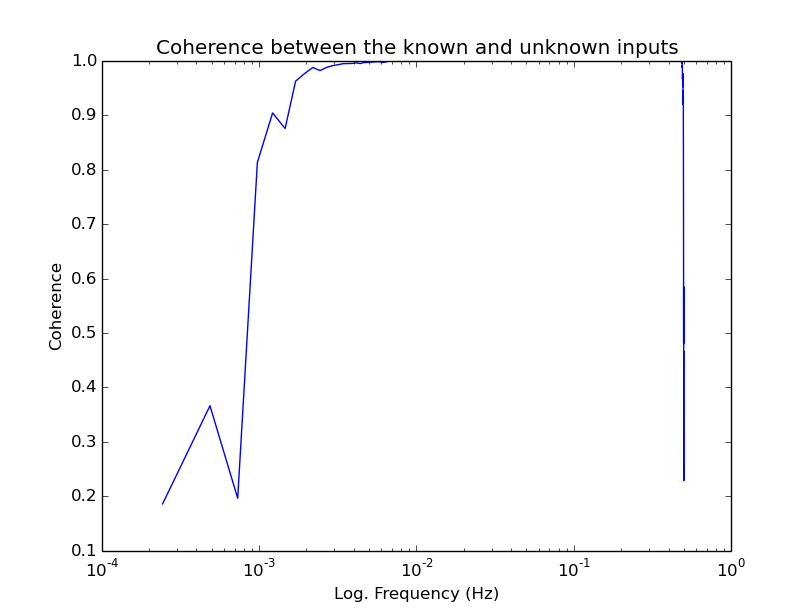
Note
Notice the excellent coherence (~1) across the entire broad band spectrum. This is critical. See Data flow & execution design more details/ explanations.
Execute:
# stage0.exe
The terminal output should be:
# stage0.exe
Stage 0: extracting epochs
Reading input data.
Truncating inputs to the overlapping time.
Extracting RESP epochs
Found a valid epoch
SEED times 2011-03-11T00:00:00.069500, 2011-03-11T23:59:59.069500
RESP epoch 2010-10-08T19:16:59, 2011-11-02T03:40:16
RESP file DATA/RESP.IU.KIP.00.LHZ
Lines 2532, 2681
Found a valid epoch
SEED times 2011-03-11T00:00:00.069500, 2011-03-11T23:59:59.069500
RESP epoch 2010-08-18T00:00:00, 2011-11-12T06:49:00
RESP file DATA/RESP.IU.KIP.10.LHZ
Lines 1610, 1766
Saving extracted epochs
Please see files
- out0.response.known for the epoch of the known instrument response
- out0.response.unknown for the epoch of the unknown instrument response
Plotting. Please wait, this may take several seconds.
And the plot:
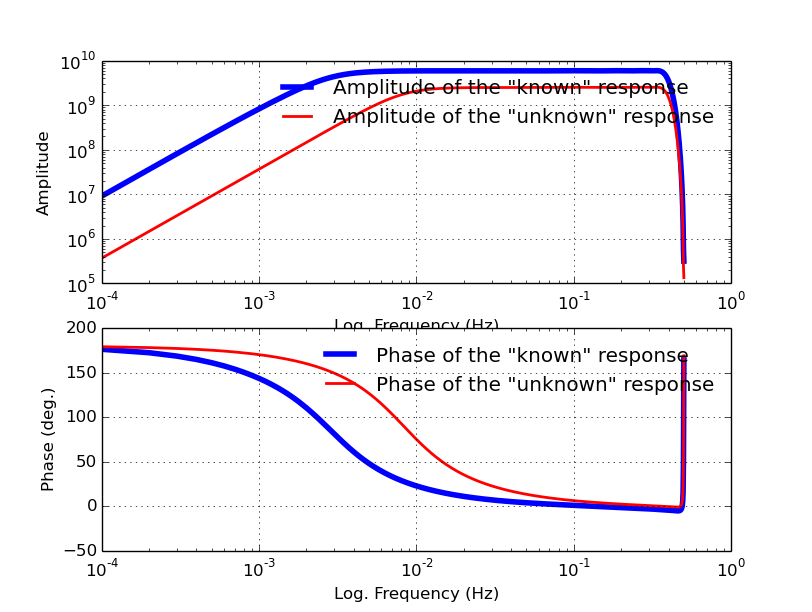
Note
Notice how the “unknown” instrument flat frequency response fits comfortably within the “known” instrument flat frequency response. This is critical. See Data flow & execution design more details/ explanations.
Execute:
# stage1e.exe
The terminal output should be:
# stage1e.exe
Stage 1: calculate transfer function
- from known input DATA/00_LHZ.512.seed
- to unknown input DATA/10_LHZ.512.seed
and restore the response for the unknown input.
Reading input data.
Truncating inputs to the overlapping time.
Determining the length of the window
Will use window length: 4096 (2**12)
Will use frequency range: [0.000122, 0.500000]
Removing DC from both input arrays.
Building prolate 4 pi window.
Calculating window's power.
Setting up temporary variables.
Allocating temporary storage.
Processing time windows:
Processing window 101 of 101.
Finished processing 101 windows.
Making exponential range of frequencies
Processing frequencies:
Processing frequency 2048 of 2048
Finished processing 2048 complex frequencies.
Please see the files:
- out1.coherence.npy for the coherence
- out1.frequency.npy for the frequency
- out1.transfer.npy for the transfer function
And the plot:

Execute:
# stage2.exe
The terminal output should be:
# stage2.exe
Stage 2: building and refining response.
Reading transfer function.
Reading npts and rang.
Reading known response out0.response.known
Building and saving raw unknown response
Building refined unknown response
Saving unknown response
Setting weights to the amplitude (may be changed in future)
Please see files
- out2.response1.npy for the restored response
- out2.response2.npy for the improved response
- out2.weight.npy for the weight
And the plot:
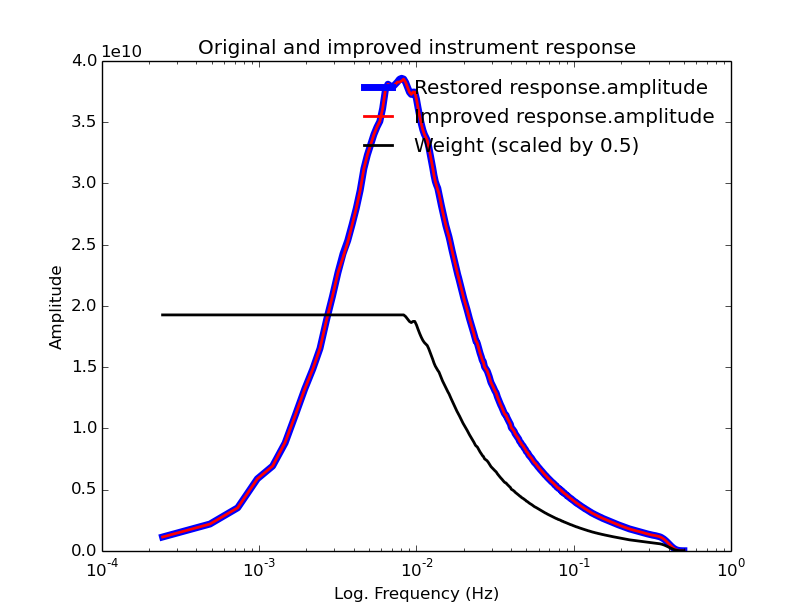
Execute:
# stage3.exe
The terminal output should be:
# stage3.exe
Stage 3: select the best degrees of polynomials and restore PZ
Reading data from previous stages
Selecting the best pair of M and N
Checking pair (1, 1)----------------
Possible configuration: num.of zeros, num.of poles, residual:
1, 1, 1942997487.57
Checking pair (1, 2)----------------
Possible configuration: num.of zeros, num.of poles, residual:
1, 2, 194889111.732
Checking pair (2, 2)----------------
Possible configuration: num.of zeros, num.of poles, residual:
2, 2, 170264112.775
Checking pair (3, 3)----------------
Possible configuration: num.of zeros, num.of poles, residual:
3, 3, 140575584.772
Checking pair (3, 4)----------------
Possible configuration: num.of zeros, num.of poles, residual:
3, 4, 122925219.943
Checking pair (4, 5)----------------
Possible configuration: num.of zeros, num.of poles, residual:
4, 5, 180129673.44
Checking pair (5, 5)---------------
Possible configuration: num.of zeros, num.of poles, residual:
5, 5, 274924592.053
Checking pair (6, 6)
The best pair is M = 3, N = 4, MAD = 122925219.943
Zeros:
[-0.01200856+3.03657707j -0.01200856-3.03657707j 0.00028787+0.j ]
Poles:
[-0.10827544+3.28341581j -0.10827544-3.28341581j -0.03373575+0.03510356j
-0.03373575-0.03510356j]
Scale:
3047993562.8
Please see files
- out3.zeros.npy for the zeros
- out3.poles.npy for the poles
- out3.scale.npy for the scale
- out3.response.npy for the response restored from poles and zeros
And the plots (there are two in this stage):
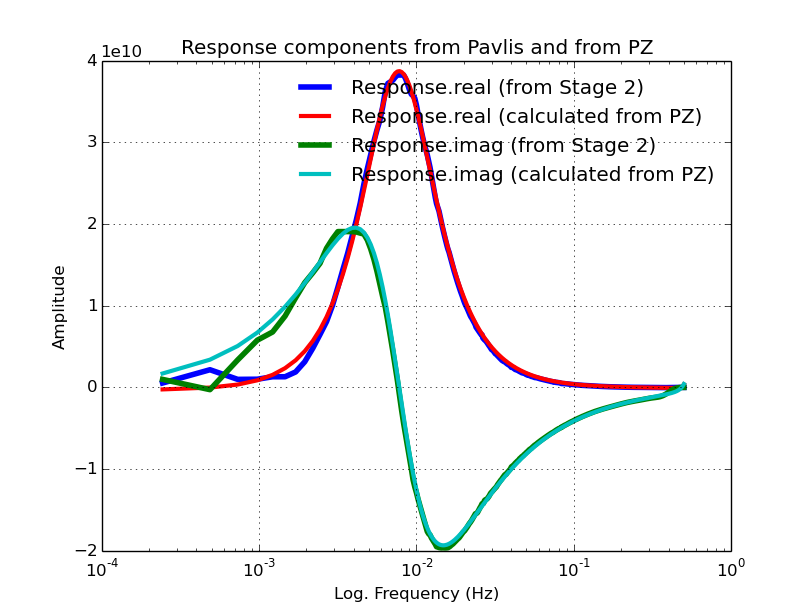
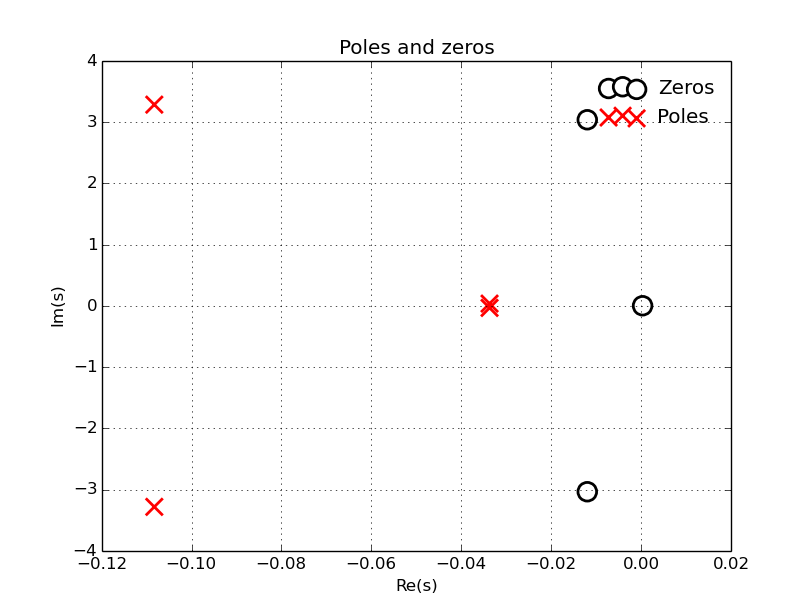
Execute:
# stage4.exe
The terminal output should be:
# stage4.exe
Stage 4 - RESP file generation
Please see file out4.response.restored for the RESP formatted output
Plotting. Please wait, this may take several seconds.
And the plot:
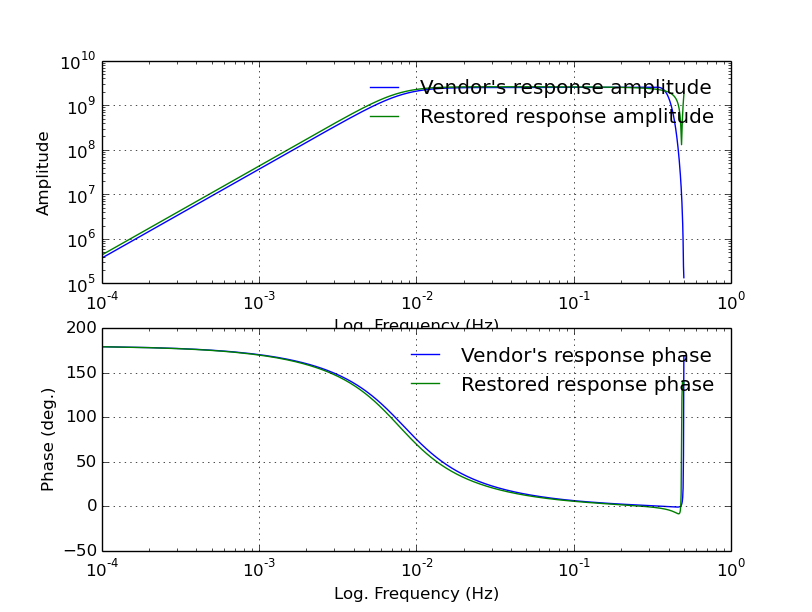
Note
The final output is a RESP-formatted instrument response file for the “unknown” sensor called out4.response.restored. It lives outside the docker container at /opt/osop/respgen/
Note
All output files live outside the docker container at /opt/osop/respgen/
Note
The “Vendor’s” response refers to the instrument response of the instrument treated as the “unknown” sensor as provided by the instrument manufacturer (or “vendor” in English) Streckeisen. The “restored” response is that generated by respGen.
Example 2: OSOP BRU2 station¶
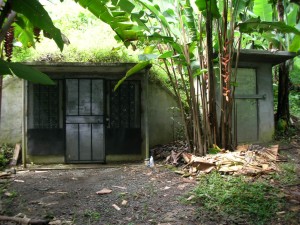
Description: <1 days of 100 sps data from 2 co-located sensors, one broad band and one short-period:
(Not included by default. Available upon request)
- “Known” instrument: a Nanometrics Trillium Compact Broadband seismometer w/ Earthdata E209 Digitizer (PA.BRU2..HHZ.D.2013.114, RESP.PA.BRU2..HHZ); and
- “Unknown” instrument: an OSOP Sixaola (v1.2) short-period seismograph (PA.BRU4..EHZ.D.2013.114, RESP.PA.BRU4..EHZ). The response for the “unknown” Sixaola seismograph (RESP.PA.BRU4..EHZ) was generated using a shake table and the SEISAN resp program.
The Nanometrics Trillium Compact has a flat frequency response that extends to lower frequencies and, therefore, is used in this example to determine the frequency response of the more band-limited Sixaola.
Links of interest:
- Learn more about BRU2 at: http://www.osop.com.pa/hardware/seismic-vault/
- Learn more about the Nanometrics Trillium Compact at: http://www.osop.com.pa/wp-content/uploads/2014/04/sismometro-nanometrics-trillium-compact.pdf
- Learn more about the OSOP Sixaola Short-Period Seismograph: http://www.osop.com.pa/hardware/seismometer/
First, configure /opt/osop/respgen/setup.py in this way:
#!/usr/bin/env python2
UFILE = 'DATA/PA.BRU4..EHZ.D.2013.114'
KFILE = 'DATA/PA.BRU2..HHZ.D.2013.114'
URESP = 'DATA/RESP.PA.BRU4..EHZ'
KRESP = 'DATA/RESP.PA.BRU2..HHZ'
OVERLAP_FRACTION = 0.8
NUM_OF_WINDOWS = 100
LOWFRQ = 0.01
NUM_OF_POINTS = 1500
MEDIAN_LEN = 7
COHE_LIMIT = 0.6
DETERMINE_DEGREE = True
NMAX = 6
NN = 4
MM = 3
NORMFREQ = 5
ZERO_LIMIT = 0.0015
Then, execute view_cohe.exe:
# view_cohe.exe
The terminal output should be:
# view_cohe.exe
Coherence of the inputs
Input from the known instrument:
DATA/PA.BRU2..HHZ.D.2013.114
Input from the unknown instrument:
DATA/PA.BRU4..EHZ.D.2013.114
Reading input data.
Truncating inputs to the overlapping time.
Determining the length of the window
Will use window length: 262144 (2**18)
Will use frequency range: [0.000191, 50.000000]
Removing DC from both input arrays.
Calculating coherence
And the plot:
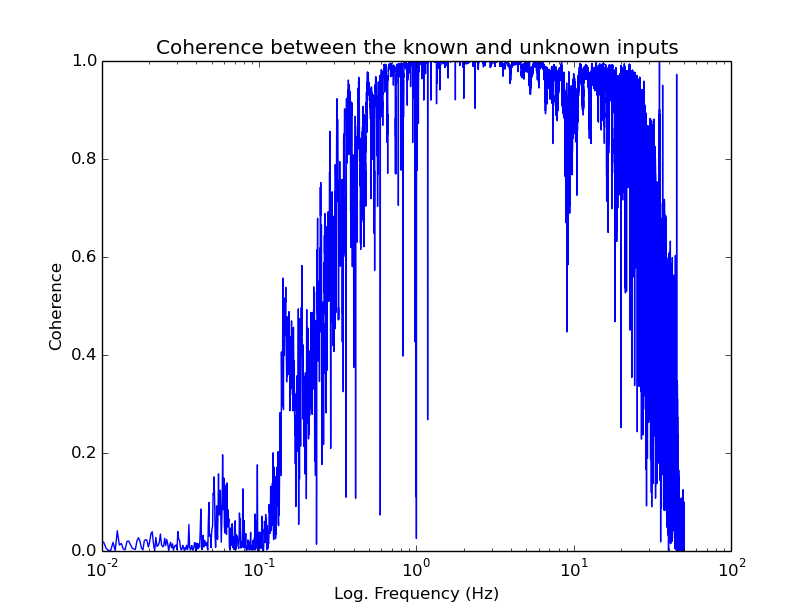
Note
In this example there is considerable less coherence between the sensors than in Example 1, but still strong coherence between the sensors in the frequency band of interest (from ~0.5 to ~0.8*Nyquist).
Execute:
# stage0.exe
The terminal output should be:
# stage0.exe
Stage 0: extracting epochs
Reading input data.
Truncating inputs to the overlapping time.
Extracting RESP epochs
Found a valid epoch
SEED times 2013-04-24T00:00:03.150000, 2013-04-24T22:43:16.500000
RESP epoch 2000-01-01T00:00:00, No ending time
RESP file DATA/RESP.PA.BRU2..HHZ
Lines 1, 1029
Found a valid epoch
SEED times 2013-04-24T00:00:03.150000, 2013-04-24T22:43:16.500000
RESP epoch 2013-01-01T00:00:00, No ending time
RESP file DATA/RESP.PA.BRU4..EHZ
Lines 1, 84
Saving extracted epochs
Please see files
- out0.response.known for the epoch of the known instrument response
- out0.response.unknown for the epoch of the unknown instrument response
Plotting. Please wait, this may take several seconds.
And the plot:

Note
Notice how the “unknown” instrument flat frequency response fits comfortably within the “known” instrument flat frequency response. This is critical. See Data flow & execution design more details/ explanations.
Execute:
# stage1.exe
The terminal output should be:
# stage1.exe
Stage 1: calculate transfer function
- from known input DATA/PA.BRU2..HHZ.D.2013.114
- to unknown input DATA/PA.BRU4..EHZ.D.2013.114
and restore the response for the unknown input.
Reading input data.
Truncating inputs to the overlapping time.
Determining the length of the window
Will use window length: 262144 (2**18)
Will use frequency range: [0.000191, 50.000000]
Removing DC from both input arrays.
Building prolate 4 pi window.
Calculating window's power.
Setting up temporary variables.
Allocating temporary storage.
Processing time windows:
Processing window 152 of 152.
Finished processing 152 windows.
Making exponential range of frequencies
Processing frequencies:
Processing frequency 131072 of 131072
Finished processing 131072 complex frequencies.
Please see the files:
- out1.coherence.npy for the coherence
- out1.frequency.npy for the frequency
- out1.transfer.npy for the transfer function
And the plot:
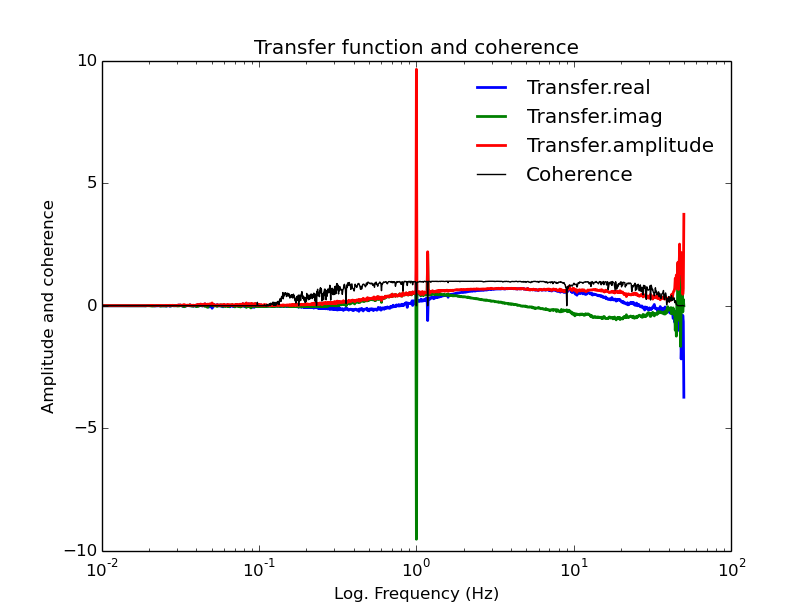
And using stage1e.exe we get:

Note
stage1e (Anatoli’s linear approximation method) is better at removing transient from the data set than stage1 is (Pavlis’ robust averaging method). See Data flow & execution design for more details.
Execute:
# stage2.exe
The terminal output should be:
# stage2.exe
Stage 2: building and refining response.
Reading transfer function.
Reading npts and rang.
Reading known response out0.response.known
Building and saving raw unknown response
Building refined unknown response
Saving unknown response
Setting weights to the amplitude (may be changed in future)
Please see files
- out2.response1.npy for the restored response
- out2.response2.npy for the improved response
- out2.weight.npy for the weight
And the plot:
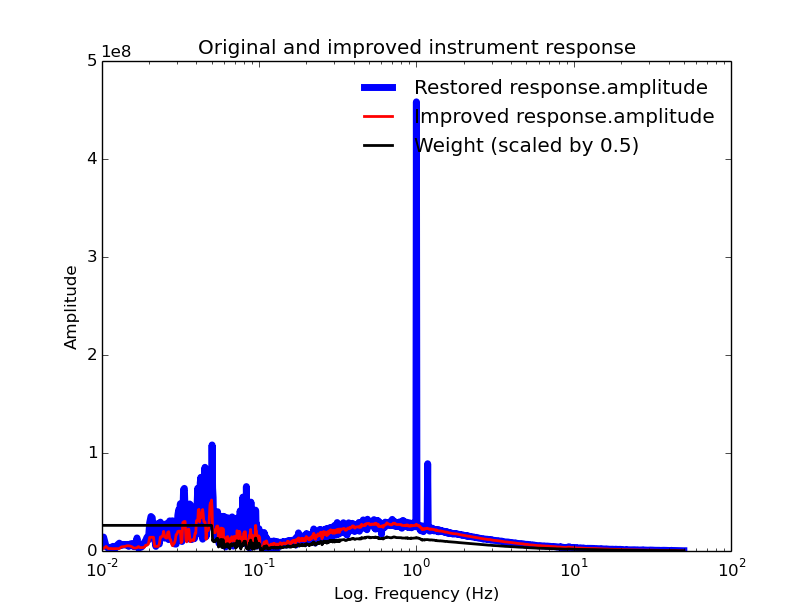
And using stage1e.exe we get:
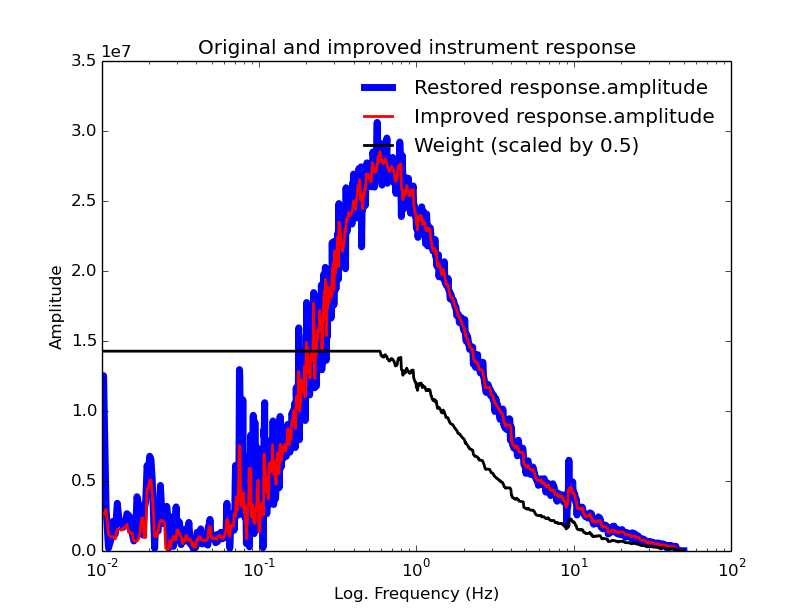
Execute:
# stage3.exe
The terminal output should be:
# stage3.exe
Stage 3: select the best degrees of polynomials and restore PZ
Reading data from previous stages
Selecting the best pair of M and N
Checking pair (1, 1)----------------
Possible configuration: num.of zeros, num.of poles, residual:
1, 1, 12617699.544
Checking pair (1, 2)----------------
Possible configuration: num.of zeros, num.of poles, residual:
1, 2, 3719501.15025
Checking pair (2, 2)----------------
Possible configuration: num.of zeros, num.of poles, residual:
2, 2, 3466779.9732
Checking pair (1, 3)----------------
Possible configuration: num.of zeros, num.of poles, residual:
1, 3, 2014740.4384
Checking pair (2, 3)----------------
Possible configuration: num.of zeros, num.of poles, residual:
2, 3, 1258024.48553
Checking pair (3, 3)----------------
Possible configuration: num.of zeros, num.of poles, residual:
3, 3, 1167039.52073
Checking pair (1, 4)----------------
Possible configuration: num.of zeros, num.of poles, residual:
1, 4, 1222050.51794
Checking pair (2, 4)----------------
Possible configuration: num.of zeros, num.of poles, residual:
2, 4, 1224031.64042
Checking pair (3, 4)----------------
Possible configuration: num.of zeros, num.of poles, residual:
3, 4, 1265323.37175
Checking pair (4, 4)----------------
Possible configuration: num.of zeros, num.of poles, residual:
4, 4, 1266138.92729
Checking pair (1, 5)----------------
Possible configuration: num.of zeros, num.of poles, residual:
1, 5, 1190477.00459
Checking pair (3, 5)----------------
Possible configuration: num.of zeros, num.of poles, residual:
3, 5, 712987.694893
Checking pair (4, 5)----------------
Possible configuration: num.of zeros, num.of poles, residual:
4, 5, 660049.943494
Checking pair (1, 6)----------------
Possible configuration: num.of zeros, num.of poles, residual:
1, 6, 1250021.29066
Checking pair (2, 6)----------------
Possible configuration: num.of zeros, num.of poles, residual:
2, 6, 661938.588146
Checking pair (3, 6)----------------
Possible configuration: num.of zeros, num.of poles, residual:
3, 6, 660087.253079
Checking pair (5, 6)----------------
Possible configuration: num.of zeros, num.of poles, residual:
5, 6, 1270335.27865
Checking pair (6, 6)----------------
Possible configuration: num.of zeros, num.of poles, residual:
6, 6, 703942.863681
The best pair is M = 4, N = 5, MAD = 660049.943494
Zeros:
[ 186.48322108 +2.53375256e+02j 186.48322108 -2.53375256e+02j
0.22014777 +1.89935425e-01j 0.22014777 -1.89935425e-01j]
Poles:
[-165.16834962+85.13403891j -165.16834962-85.13403891j -4.72499488 +0.j
-2.90319706 +0.j -1.09210152 +0.j ]
Scale:
74994916.8812
Please see files
- out3.zeros.npy for the zeros
- out3.poles.npy for the poles
- out3.scale.npy for the scale
- out3.response.npy for the response restored from poles and zeros
And the plots (there are two in this stage):
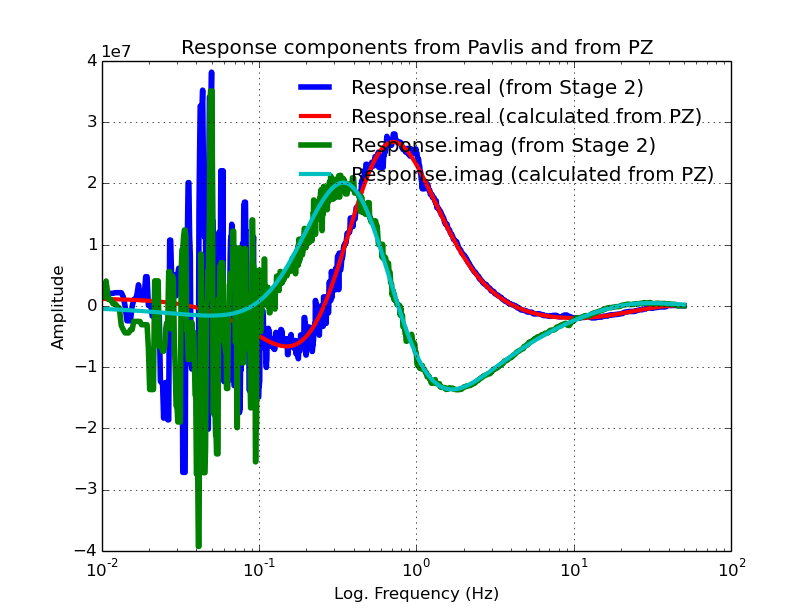

And using stage1e.exe we get:
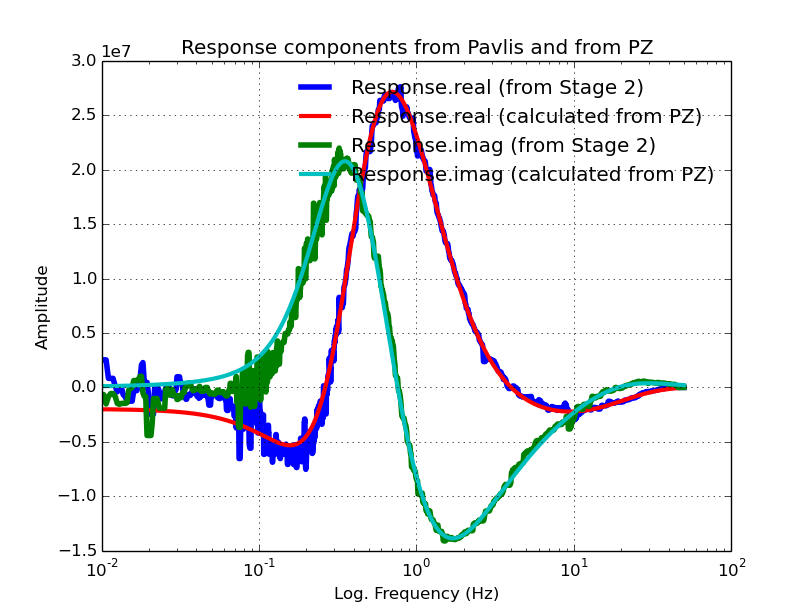
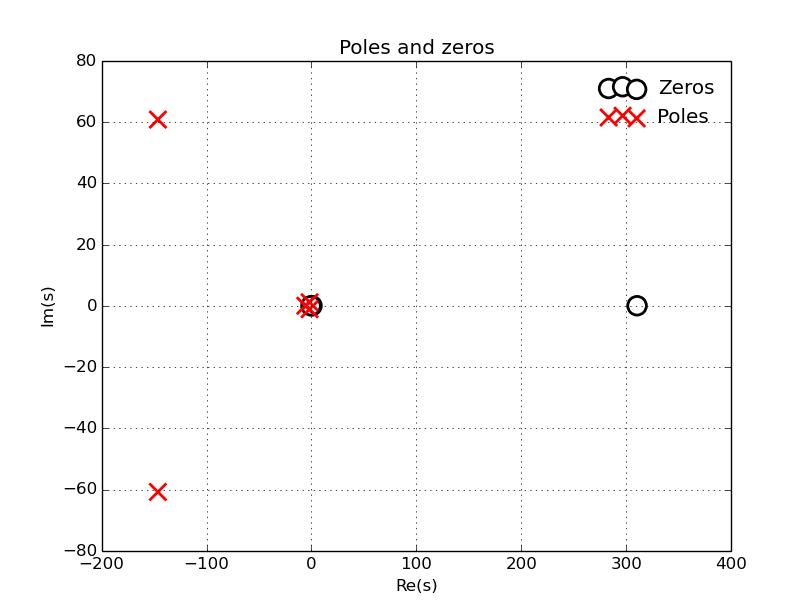
Execute:
# stage4.exe
The terminal output should be:
# stage4.exe
Stage 4 - RESP file generation
Please see file out4.response.restored for the RESP formatted output
Plotting. Please wait, this may take several seconds.
And the plot:
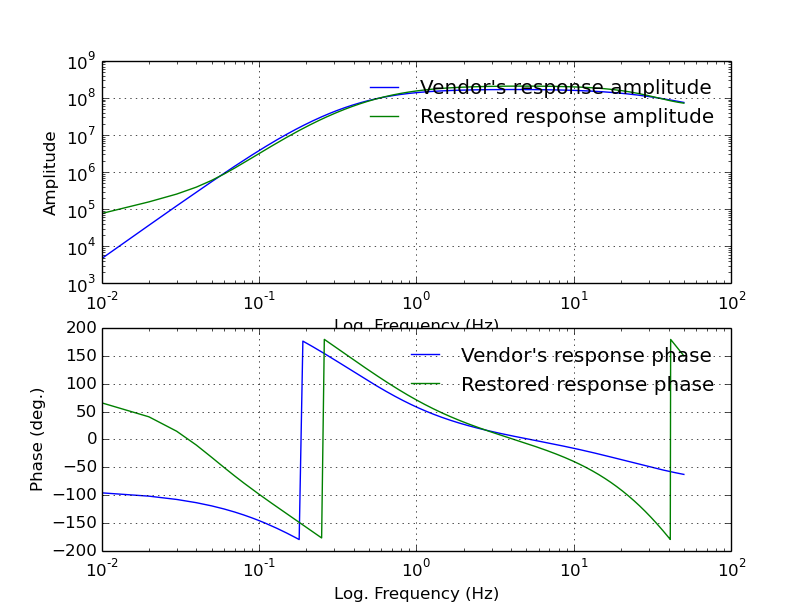
Note
The final output is a RESP-formatted instrument response file for the “unknown” sensor called out4.response.restored. It lives outside the docker container at /opt/osop/respgen/
Note
All output files live outside the docker container at /opt/osop/respgen/
Note
The “Vendor’s” response refers to the instrument response of the instrument treated as the “unknown” sensor as provided by the instrument manufacturer (or “vendor” in English) OSOP. The “restored” response is that generated by respGen.